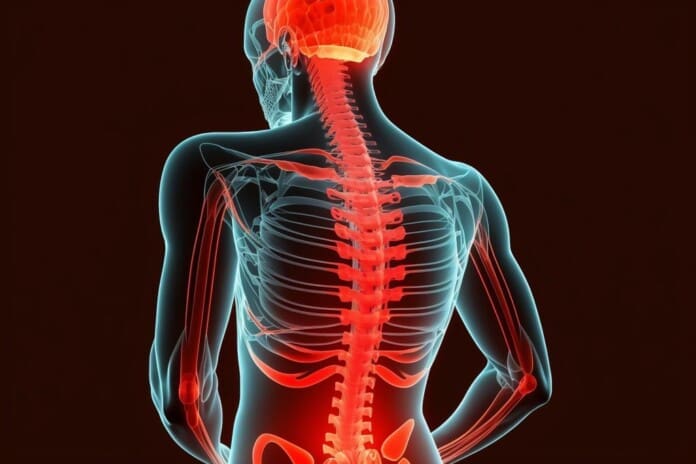Uncover the benefits of chiropractic care in reducing rheumatoid arthritis and inflammation to improve your health and wellness journey.
Table of Contents
Chiropractic Care and Lifestyle Changes for Managing Rheumatoid Arthritis Inflammation
Rheumatoid arthritis (RA) is like an uninvited guest that crashes the party in your joints, causing pain, swelling, and stiffness that can make daily life feel like a marathon with hurdles. This chronic autoimmune condition affects about 1% of the global population, with women being two to three times more likely to develop it than men. While RA can feel like a heavyweight champion pummeling your joints, there are ways to fight back without resorting to surgery. Chiropractic care, anti-inflammatory diets, and small lifestyle changes can team up to reduce inflammation and improve your quality of life. In El Paso, TX, Dr. Alexander Jimenez, DC, APRN, FNP-BC, is a leading expert in helping patients manage RA symptoms and personal injury cases with a unique blend of clinical expertise and advanced diagnostic techniques. This blog post dives into how RA affects the joints, why chiropractic care and lifestyle tweaks work, and how Dr. Jimenez’s approach makes a difference—sprinkled with a bit of humor to keep things light, because who said fighting inflammation can’t have a few laughs?
Understanding Rheumatoid Arthritis and Inflammation
What Is Rheumatoid Arthritis?
Rheumatoid arthritis is an autoimmune disorder where your immune system mistakenly attacks your body’s own tissues, particularly the synovium—the thin membrane lining your joints. Think of your immune system as a well-meaning but overzealous security guard who starts tackling innocent bystanders (your joints) instead of the bad guys. This attack causes inflammation, leading to pain, swelling, and stiffness, most commonly in the hands, wrists, and knees, though it can affect other joints too.
Unlike osteoarthritis, which is caused by wear and tear, RA is driven by an immune system gone rogue. The inflammation can erode cartilage and bone, leading to joint damage and deformities over time. It’s like your joints are stuck in a never-ending wrestling match with no referee to call it off. Symptoms can vary, from mild aches to severe pain that makes even buttoning a shirt feel like solving a Rubik’s Cube.
The Role of Inflammation in RA
Inflammation is the body’s natural response to injury or infection, but in RA, it’s like the body’s alarm system is stuck on high alert. The immune system releases inflammatory chemicals like cytokines, which attack the synovium, causing it to thicken and produce excess fluid. This leads to swollen, tender joints and can damage surrounding tissues, including cartilage, bone, and ligaments (Smolen et al., 2020).
Inflammation in RA doesn’t just stay in the joints—it can affect other parts of the body, like the heart, lungs, and eyes, making it a systemic condition. It’s like RA decided to throw a tantrum and mess up the whole house, not just one room. Chronic inflammation also contributes to fatigue, which can make you feel like you’re running on empty even after a full night’s sleep.
How RA Affects Daily Life
RA can turn simple tasks into Olympic-level challenges. Imagine trying to open a jar of pickles when your hands feel like they’ve been through a boxing match. The pain and stiffness can limit mobility, reduce strength, and make it hard to keep up with work, hobbies, or even playing with your kids. Over time, joint damage can lead to reduced proprioception (your body’s sense of where it is in space), making movements clumsy and increasing the risk of falls (Ligouri et al., 2020).
For those in El Paso, TX, where active lifestyles are common, RA can be especially frustrating. Whether it’s hiking in the Franklin Mountains or just carrying groceries, joint pain can put a damper on your plans. But don’t worry—there’s hope, and it doesn’t involve turning your life into a medical drama.
References
- Ligouri, G. C., Schinzel, V., & Felson, D. T. (2020). The effects of joint damage on muscle function, proprioception and rehabilitation. PubMed. https://pubmed.ncbi.nlm.nih.gov/32060757/
- Smolen, J. S., Aletaha, D., & McInnes, I. B. (2020). Role of joint damage, malalignment and inflammation in articular tenderness in rheumatoid arthritis, psoriatic arthritis and osteoarthritis. PubMed. https://pubmed.ncbi.nlm.nih.gov/33051219/
The Clinical Rationale for Chiropractic Care in RA
Why Chiropractic Care?
Chiropractic care might sound like something reserved for bad backs or that time you tried to “lift with your back” instead of your legs, but it’s a powerful tool for managing RA inflammation. Chiropractors like Dr. Alexander Jimenez in El Paso focus on restoring joint alignment and improving nervous system function through gentle, targeted adjustments. These adjustments help reduce joint stress, improve mobility, and—most importantly—calm inflammation without invasive procedures.
Chiropractic care works by addressing subluxations (misalignments) in the spine and joints, which can exacerbate RA symptoms. Misaligned joints can increase pressure on nerves, amplifying pain and inflammation signals. By realigning the joints, chiropractors help the body function more smoothly, like tuning up a car to stop it from rattling down the road (Murphy et al., 2020).
How Chiropractic Reduces Inflammation
Chiropractic adjustments can influence the nervous system, which plays a big role in regulating inflammation. The vagus nerve, a key player in the body’s anti-inflammatory response, can be indirectly stimulated through spinal adjustments, helping to dial down the immune system’s overreaction (Kox & Pickkers, 2020). It’s like telling your immune system, “Hey, chill out, the joints aren’t the enemy!”
Studies show that joint manipulation can reduce pain and improve function in patients with inflammatory conditions like RA (Murphy et al., 2020). By improving joint mobility, chiropractic care helps prevent the stiffness that makes RA feel like your joints are auditioning for a role as rusty hinges. This improved mobility also enhances blood flow, delivering nutrients to damaged tissues and flushing out inflammatory chemicals.
Dr. Jimenez’s Approach
Dr. Alexander Jimenez, a chiropractor and nurse practitioner in El Paso, brings a unique perspective to RA treatment. With his dual expertise, he combines chiropractic adjustments with advanced diagnostic techniques to create personalized treatment plans. At his Sciatica Pain and Treatment Clinic, Dr. Jimenez uses tools like X-rays, MRIs, and dual-scope procedures to pinpoint the exact source of joint dysfunction and inflammation (Sciatica Clinic, n.d.). His approach is like a detective solving a mystery, using cutting-edge tech to find the culprit behind your pain.
For RA patients, Dr. Jimenez focuses on gentle, low-force adjustments to avoid aggravating inflamed joints. He also incorporates physical therapy and rehabilitation exercises to strengthen the muscles around the joints, improving stability and reducing the risk of further damage (Ligouri et al., 2020). His patients often report feeling like they’ve gone from creaky old robots to smooth-moving machines.
Benefits Beyond the Joints
Chiropractic care doesn’t just help your joints—it can improve your overall well-being. Reducing pain and stiffness makes daily activities easier, whether it’s tying your shoes or chasing after your dog. It also promotes better sleep, which is crucial for RA patients who often struggle with fatigue. Plus, chiropractic care can boost your mood—because who doesn’t feel better when their body stops acting like it’s auditioning for a horror movie?
References
- Kox, M., & Pickkers, P. (2020). Vagus nerve stimulation in musculoskeletal diseases. PubMed. https://pubmed.ncbi.nlm.nih.gov/32413853/
- Murphy, D. R., Taylor, J. A., & Stark, J. J. (2020). Indications for joint manipulation. PubMed. https://pubmed.ncbi.nlm.nih.gov/32024822/
- Sciatica Clinic. (n.d.). Sciatica pain and treatment clinic. https://sciatica.clinic/
Arthritis Explained- Video

The Power of an Anti-Inflammatory Diet
Why Diet Matters
If inflammation is the fire fueling RA, your diet is like the fire hose that can help put it out. An anti-inflammatory diet focuses on foods that reduce the body’s inflammatory response, helping to ease joint pain and stiffness. It’s not about eating boring salads all day—think of it as giving your body a superhero smoothie to fight off the bad guys.
Foods rich in omega-3 fatty acids, antioxidants, and fiber can lower levels of inflammatory markers like C-reactive protein (CRP), which is often elevated in RA (Personal Injury Doctor Group, 2017). By choosing the right foods, you can support your joints and give your immune system a much-needed timeout.
Foods to Embrace
Here’s a lineup of anti-inflammatory foods that can help you manage RA:
- Fatty Fish: Salmon, mackerel, and sardines are packed with omega-3s, which act like a calming balm for inflamed joints.
- Fruits and Vegetables: Berries, spinach, and broccoli are loaded with antioxidants that neutralize free radicals, the troublemakers behind inflammation.
- Nuts and Seeds: Walnuts and flaxseeds are like tiny anti-inflammatory powerhouses.
- Whole Grains: Quinoa and brown rice provide fiber to keep inflammation in check.
- Organic Teas: Green tea and ginger tea contain polyphenols that reduce inflammation, making them a soothing addition to your routine (Personal Injury Doctor Group, 2017).
Foods to Avoid
Some foods are like throwing gasoline on the inflammation fire. Limit or avoid:
- Processed Foods: Chips, cookies, and fast food are high in trans fats and sugars that fuel inflammation.
- Red Meat: High in saturated fats, it can worsen RA symptoms.
- Sugary Drinks: Soda and energy drinks spike blood sugar, which can trigger inflammation.
Making It Work in Your Routine
You don’t need to overhaul your kitchen overnight. Start small—swap out soda for green tea, or add a handful of berries to your breakfast. Dr. Jimenez often advises his patients to keep a food diary to track how their diet affects their symptoms. It’s like being your own nutrition detective, figuring out what makes your joints cheer or jeer.
References
- Personal Injury Doctor Group. (2017, March 28). Organic teas help inflammation caused by rheumatoid arthritis. https://personalinjurydoctorgroup.com/2017/03/28/organic-teas-help-inflammation-caused-by-rheumatoid-arthritis/
Small Lifestyle Changes for Big Results
Exercise: Move It or Lose It
Exercise might sound like the last thing you want to do when your joints are screaming, but gentle movement is like oiling a squeaky door. Low-impact activities like swimming, yoga, or walking can improve joint mobility, reduce stiffness, and boost circulation, which helps flush out inflammatory chemicals (Ligouri et al., 2020).
Dr. Jimenez often recommends tailored exercise plans for his RA patients, focusing on strengthening the core and supporting muscles around the joints. Think of it as building a team of bodyguards to protect your joints from further damage. Even 10 minutes of stretching a day can make a difference—your joints will thank you for not treating them like rusty nails.
Stress Management: Keep Calm and Carry On
Stress is like a megaphone for inflammation—it amplifies RA symptoms by increasing cortisol and cytokine levels. Techniques like deep breathing, meditation, or even laughing at a good comedy can lower stress and help your body relax. Chiropractic care also plays a role here, as adjustments can stimulate the vagus nerve, promoting a calming effect on the nervous system (Kox & Pickkers, 2020).
Sleep: The Ultimate Recharge
Poor sleep is like giving RA an all-access pass to wreak havoc. Aim for 7-8 hours of quality sleep by creating a relaxing bedtime routine—think warm tea, a good book, and no screens. Proper spinal alignment from chiropractic care can also improve sleep by reducing pain that keeps you tossing and turning.
Posture: Stand Tall, Feel Better
Bad posture is like asking your joints to carry a backpack full of bricks. Dr. Jimenez emphasizes proper posture to reduce stress on inflamed joints. Simple tweaks, like using a lumbar pillow while sitting or keeping your shoulders back, can prevent subluxations and ease RA symptoms.
References
- Kox, M., & Pickkers, P. (2020). Vagus nerve stimulation in musculoskeletal diseases. PubMed. https://pubmed.ncbi.nlm.nih.gov/32413853/
- Ligouri, G. C., Schinzel, V., & Felson, D. T. (2020). The effects of joint damage on muscle function, proprioception and rehabilitation. PubMed. https://pubmed.ncbi.nlm.nih.gov/32060757/
Dr. Alexander Jimenez and Personal Injury Cases in El Paso
Why Personal Injury Matters
In El Paso, personal injury cases—like car accidents or workplace injuries—can worsen RA symptoms or even trigger flare-ups. Trauma from an accident can misalign joints, increase inflammation, and make daily life even tougher. Dr. Alexander Jimenez is a trusted name in El Paso for helping personal injury victims recover, combining his chiropractic expertise with advanced diagnostic tools to create a roadmap to healing.
Dr. Jimenez’s Unique Approach
Dr. Jimenez stands out for his ability to bridge medical care and legal documentation. Using advanced imaging like X-rays and MRIs, along with dual-scope procedures (combining arthroscopy and imaging), he accurately diagnoses injuries and their impact on RA (Sciatica Clinic, n.d.). This precision is crucial for personal injury cases, where clear documentation can make or break a legal claim. It’s like having a translator who speaks both “doctor” and “lawyer” fluently.
For RA patients involved in personal injury cases, Dr. Jimenez tailors treatment plans to address both the injury and the underlying autoimmune condition. His chiropractic adjustments reduce joint stress, while rehabilitation exercises restore function, helping patients get back to their lives—whether that’s dancing at a quinceañera or just carrying groceries without wincing.
A Liaison Between Medicine and Law
Dr. Jimenez’s dual expertise as a chiropractor and nurse practitioner allows him to provide detailed medical reports that support legal claims. He works closely with attorneys to ensure that injuries are properly documented, helping victims secure the compensation they need for treatment and recovery. In a city like El Paso, where car accidents are common, this expertise is invaluable (LinkedIn, n.d.).
References
- LinkedIn. (n.d.). Dr. Alexander Jimenez. https://www.linkedin.com/in/dralexjimenez/
- Sciatica Clinic. (n.d.). Sciatica pain and treatment clinic. https://sciatica.clinic/
Overlapping Risk Profiles: RA and Musculoskeletal Health
Shared Risk Factors
RA shares risk factors with other musculoskeletal conditions, like obesity, sedentary lifestyles, and hormonal changes, particularly in midlife women (Gasparyan et al., 2020). Excess weight puts extra stress on joints, while a lack of movement can worsen stiffness. Hormonal shifts, especially during menopause, can also increase inflammation, making RA symptoms more intense.
How Chiropractic and Lifestyle Help
Chiropractic care addresses these risks by improving joint alignment and mobility, reducing the strain caused by excess weight or poor posture. An anti-inflammatory diet tackles obesity and inflammation at the source, while regular exercise keeps joints limber and strengthens supporting muscles. Dr. Jimenez’s holistic approach combines these strategies to create a comprehensive plan that tackles RA from multiple angles.
Preventing Long-Term Damage
Untreated RA can lead to joint deformities and loss of function, making prevention key. Regular chiropractic care, a healthy diet, and an active lifestyle can slow disease progression and protect your joints. It’s like giving your body a suit of armor to fend off RA’s attacks.
References
- Gasparyan, A. Y., Ayvazyan, L., & Blackmore, H. (2020). Osteoarthritis: The importance of hormonal status in midlife women. PubMed. https://pubmed.ncbi.nlm.nih.gov/32060759/
Practical Tips for RA Management
Daily Routine Tweaks
- Morning Stretches: Start your day with 5-10 minutes of gentle stretching to loosen up joints. Think of it as waking your joints up with a cup of coffee.
- Hydration: Drink plenty of water to keep joints lubricated and flush out toxins.
- Ergonomic Tools: Use tools like jar openers or ergonomic keyboards to reduce strain on your hands.
- Heat and Cold Therapy: Apply a warm compress to ease stiffness in the morning, and use ice packs for swelling after activity.
Working with a Chiropractor
Schedule regular visits with a chiropractor like Dr. Jimenez to keep your spine and joints aligned. Be honest about your symptoms and lifestyle—it helps your chiropractor create a plan that fits you like a glove. Follow through with recommended exercises and dietary changes for the best results.
Staying Positive
RA can be a tough opponent, but a positive mindset is like having a secret weapon. Surround yourself with supportive friends, join a local RA support group in El Paso, or try journaling to process your feelings. A good laugh doesn’t hurt either—watch a funny movie to keep your spirits high.
Conclusion
Rheumatoid arthritis is a serious condition that requires a comprehensive approach to manage effectively. Chiropractic care, under the guidance of experts like Dr. Alexander Jimenez in El Paso, TX, offers a non-surgical way to reduce inflammation, improve joint function, and enhance quality of life. Combined with an anti-inflammatory diet and small lifestyle changes, these strategies can help you take control of RA and its impact on your daily routine. For those dealing with personal injury cases, Dr. Jimenez’s expertise in diagnostics and legal documentation ensures that patients receive both top-notch care and the support needed for their claims.
Disclaimer: This blog post is for informational purposes only and should not be taken as medical advice. Always consult with a qualified healthcare provider, such as a chiropractor or physician, before starting any new treatment or making significant lifestyle changes. Rheumatoid arthritis is a complex condition, and treatment plans should be tailored to your individual needs by a professional.
References
- Gasparyan, A. Y., Ayvazyan, L., & Blackmore, H. (2020). Osteoarthritis: The importance of hormonal status in midlife women. PubMed. https://pubmed.ncbi.nlm.nih.gov/32060759/
- Kox, M., & Pickkers, P. (2020). Vagus nerve stimulation in musculoskeletal diseases. PubMed. https://pubmed.ncbi.nlm.nih.gov/32413853/
- Ligouri, G. C., Schinzel, V., & Felson, D. T. (2020). The effects of joint damage on muscle function, proprioception and rehabilitation. PubMed. https://pubmed.ncbi.nlm.nih.gov/32060757/
- Murphy, D. R., Taylor, J. A., & Stark, J. J. (2020). Indications for joint manipulation. PubMed. https://pubmed.ncbi.nlm.nih.gov/32024822/
- Personal Injury Doctor Group. (2017, March 28). Organic teas help inflammation caused by rheumatoid arthritis. https://personalinjurydoctorgroup.com/2017/03/28/organic-teas-help-inflammation-caused-by-rheumatoid-arthritis/
- Sciatica Clinic. (n.d.). Sciatica pain and treatment clinic. https://sciatica.clinic/
- Smolen, J. S., Aletaha, D., & McInnes, I. B. (2020). Role of joint damage, malalignment and inflammation in articular tenderness in rheumatoid arthritis, psoriatic arthritis and osteoarthritis. PubMed. https://pubmed.ncbi.nlm.nih.gov/33051219/

































